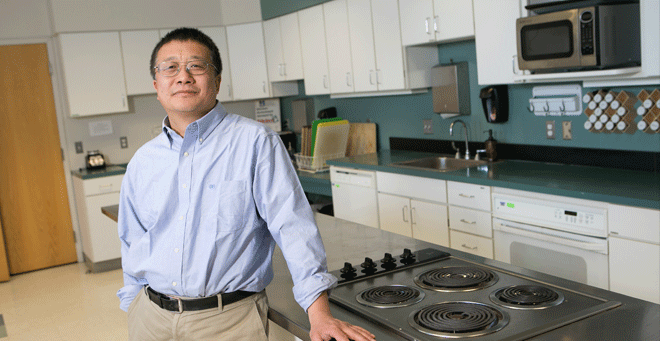 |
|
|
Yunsheng Ma, MD, PhD |
Researchers at UMass Medical School and UMass Lowell are collaborating on a new cyberinfrastructure technology that will enable patients, researchers and physicians to transport and store large quantities of data, including sensitive information, through a secure system. The system, called Flexware, will be pilot tested in a clinical trial to more accurately estimate the caloric intake of obese patients. The project is funded by a $1 million grant from the National Science Foundation.
“We are doing this research because people often have difficulty recording what they eat, the portion size and where they eat,” said Yunsheng Ma, MD, PhD, associate professor of medicine. “Accurate estimation of dietary intake, especially caloric intake, is important for assessing the effectiveness of weight loss interventions.”
Dr. Ma, who is the principal investigator on the project at the medical school, and Barbara Olendzki, RD, MPH, assistant professor of medicine, will act as clinical collaborators with the team from UMass Lowell, which includes principal investigator Vinod Vokkarane, PhD, associate professor of electrical and computer engineering, and co-principal investigators Yu Cao, PhD, assistant professor of computer science, and Yan Luo, PhD, associate professor of electrical and computer engineering.
As part of the Network Cyberinfrastructure for Biomedical Informatics Innovation project, Drs. Cao, Vokkarane and Luo will create a network cyber infrastructure for biomedical information flexible co-scheduling middleware engine (referred to as Flexware) that will enable patients, researchers and physicians to transport and store large quantities of data, including sensitive information pertaining to an individual’s health, through a secure system.
“This project will have significant impacts on improving the quality of health care applications; providing clinical and scientific researchers with flexible and efficient network resource allocation for studying patient behavior; and training the next generation workforce in medical and engineering fields,” Vokkarane said.
As a means to test the network, Ma will pilot a study that incorporates the Flexware network that considers how people record what and where they eat, as well as portion sizes.
The current method of caloric estimation, called 24-hour-dietary recall, is a research technique that asks individuals to recall foods and beverages they consumed in the 24-hours prior to an interview. Ma said it does not provide an accurate record of what a patient ate or drank because it relies too heavily upon memory. It also does not prompt people to be aware of what they’re consuming. In order to increase the accuracy of self-reported dietary estimates and reduce patient-bias, technology-based enhancements are needed, he said.
“This study has significant implications in a clinical setting for weight management. The motivation behind this study is to find another way to estimate calories with just a snapshot or a video of the food intake,” Ma said.
Although technology-based estimation of caloric intake is still a challenging task and an open research problem, the new machine-learning-based computing techniques the UMass Lowell team is actively developing will be secure and have huge potential to address this issue and to transform the field, Cao said.
The engineers and researchers said that they are sensitive to the photos and videos that will be shared over the network and the possibility that the individual sharing the information could be identified in the images. To address this challenge, they are developing Flexware in such a manner to ensure the privacy of the participant in the study by blurring the human body in the image while he or she records food intake.
“The security policies on data transfer will be enforced with the emerging software defined networking technologies to ensure secure data paths from homes to the data centers,” Lou said.
In addition to the digital and cyber infrastructure, scientists and engineers will create a large-scale multimedia food database that will enable them to derive the dietary intake information unobtrusively and automatically.
“It has become popular for individuals to take photos of meals and post to Facebook, Instagram and Snapchat or text photos to others. Our new approach relies on a multimedia food journal (video and audio record), which enhances our ability to assess and analyze food intake. This study has the potential for significant breakthroughs for the development of mobile cloud dietary assessment, which can lead to increased awareness of intake and subsequent change that can address weight-related conditions such as diabetes,” Ma said.